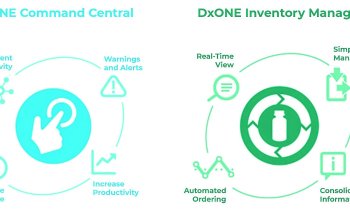Article • POCT
Integrating three laboratories
Interview: Walter Depner
For POCT, point-of-care testing, a lab has to purchase new equipment, perform new measurements and handle new parameters – right? Right! However, more importantly, POCT requires the adaptation and integration of the existing lab organisation, with all its consequences, from additional quality control down to new areas of responsibility. Dr Herbert Stekel is currently integrating three previously external lab operations, including POCT, into one central lab at his 1,000-bed hospital in Linz, Austria. In conversation with EH correspondent Walter Depner, he outlines the regulations and complexities.
Asked what exactly ISO 22870 means for POCT, GP Dr Herbert Stekel pointed out that, like any other standard, ISO 22870 offers recommendations. ‘It defines technical, management and quality requirements. A crucial aspect is the fact that the standard places responsibility for POCT firmly in the lab – this includes the selection of equipment and methods, staff training and quality control during operations.’
Depner: Another more general question: ISO, the International Organisation for Standardisation, has currently more than 160 member states covering the majority of the global population. Is any standard that was adopted by ISO automatically binding in all member states?
Stekel: ‘It’s applicable – but not binding. Standards organisations have no legislative powers. Thus a standard needs to be adopted by the legislature in order to become legally binding, for example through integration in the medical device law, or a similar act. However, beyond this legal issue standards reflect current knowledge and provide a basis for expert opinions. Therefore, healthcare facilities are well-advised to adopt the recommendations defined in a standard.’

POCT affects many hospital IT areas, from the lab information system (LIS) to the hospital information system (HIS). The integration of POCT in these systems involves software as well as hardware issues. How complex is this integration?
‘POCT is an organisational structure to provide lab services. To be able to establish proper documentation, a link to a LIS or HIS is recommended. This link is an important selection criterion: modern systems offer easy integration; some include even remote device monitoring.’
What does the standard adoption imply for staff – be it training, quality control, technical support or responsibilities? Can current lab members (or staff in other areas) handle additional tasks created by POCT, or are more technicians needed?
‘As far as I can tell from our 1,000-bed facility, 1.5 full-time equivalent of a medical-technical assistant is required. This will also cover on-site support for blood gas analysers, training, internal testing and a hotline.’
POCT is performed in ambulances, cars, helicopters, at traffic accidents, in hospital departments, lab satellites, and there are patient self-measurements. The lab must carry the greater part of this burden. How can it cope with this additional work?
‘To be precise, according to ISO 22870, patient self-measurement is not POCT. I mentioned the additional staff requirements above – no doubt POCT cannot be implemented en passant if all aspects, particularly training, are taken seriously. In terms of professional knowledge, POCT is not challenging for a lab team. The hospital and lab teams consider the closer and personal contact between labs and departments is a positive side effect of POCT.’
It won’t suffice to follow ISO guidance. Quality obligations include mandatory ring trials. How does your lab handle those, and how is that handled among international labs?
‘In addition to purchased ring trials for blood gases, we use controls and ring trials we designed ourselves. Some systems that integrate inter alia glucose measuring devices support control measurements on different levels.’
In your lab, you are in the process of integrating three different lab sites. Does POCT make your task easier or more difficult?
‘In our current situation harmonising the POCT environments is an additional task. As always, when organic structures are about to be changed, plans, patience and a lot of persuading are needed to get buy-in from the team. Processes need to be adjusted and even re-designed. But in the end you will also find many synergies. It’s really worth the effort.’
Profile:
As a specialist in medical-chemical laboratory diagnostics, general practitioner Herbert Stekel MD, heads the Institute for Medical and Chemical Laboratory Diagnostics at Kepeler University Hospital Linz, Austria. His professional focus is on lab organisation, lab economics, POCT, pre-analytics and lab IT.
27.10.2017











